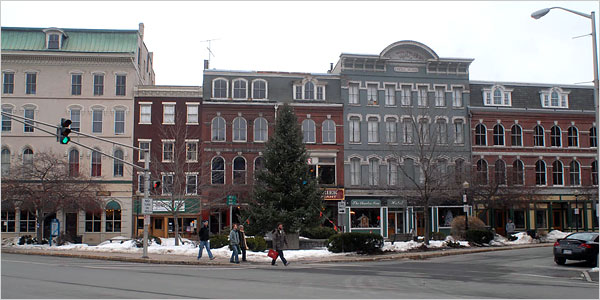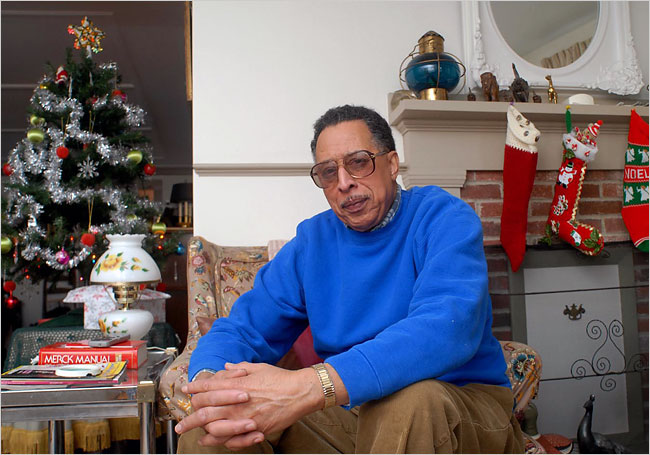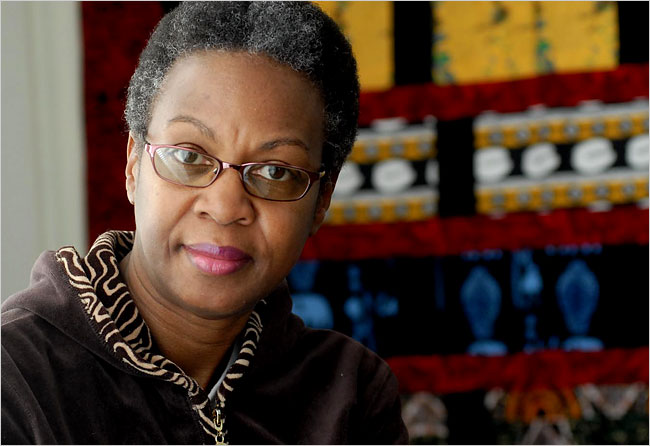| Want to send this page or a link to a friend? Click on mail at the top of this window. |
More Special Reports |
| Posted December 29, 2007 |
| Threat in Maine, the Whitest State, Shakes Local N.A.A.C.P. |
 |
|
PHOTOGRAPHS BY LINDA COAN O'KRESIK FOR THE NEW YORK TIMES |
|
| Bangor is home to the N.A.C.P.'s northern Maine chapter. A white man threatened to kill any black at its meetings. |
By ABBY GOODNOUGH |
BANGOR, Me. — In October, the N.A.A.C.P. chapter for northern Maine got shocking news. A man from a nearby town had threatened to shoot “any and all black persons” attending the group’s meetings at an old stone church here, and state prosecutors were worried enough to seek a restraining order.
Such remarks are not unheard of in Maine, the nation’s whitest state, which has fewer black residents — 10,918 in 2006, or less than 1 percent of the population, according to the Census Bureau — than some neighborhoods of Chicago or New York. But nor are they usually so blunt. The chapter has since held meetings at police stations and canceled its annual Kwanzaa celebration, which normally draws people from up and down the coast of Maine.
“It’s discouraging and it’s heart-wrenching,” said Joseph Perry, president of the chapter, which has 175 members from Augusta to the Canadian border. “There are still people who aren’t comfortable, who don’t feel safe.”
 |
| Given the threat, said Joseph Perry, chapter president, "there are still people who aren't comfortable, who don't feel safe." |
The man who made the threat was Kendrick Sawyer, 75, whose doctor at a veterans hospital in Augusta reported it to the police. Mr. Sawyer also said that Maine “should be a ‘white’ state,” according to court documents, and that he owned a .45-caliber handgun. No criminal charges have been filed, but law enforcement officers removed the gun from Mr. Sawyer’s home in Brewer, across a river from Bangor, and the Maine attorney general’s office filed a civil complaint against him.
“This man’s threat was shocking in its specificity and the anger it contained,” said Thomas Harnett, the assistant attorney general for civil rights education and enforcement. “It’s not often you see something articulated so clearly and so filled with acknowledged prejudice.”
Still, Mr. Harnett said his office received 250 to 300 reports of bias incidents every year from around the state, most of them racially motivated.
Many come from Lewiston, where more than 3,000 Somali immigrants have settled in recent years. In July 2006, a group of Somalis were worshiping in a storefront mosque there when a white man rolled the head of a pig, an animal considered unclean in Islam, across the floor. And last month, a Somali student at Lewiston High School said, a white man threw sand and dirt in his face as he ran at a cross-country meet.
Last year, a white man shouted racial slurs at a pregnant black woman in Hancock, near Bangor, and kicked her in the abdomen, according to Mr. Harnett’s office. And in March, Assata Sherrill, a black resident of Bangor, told the police that three white boys had thrown stones and shouted racial epithets at her as she walked her dog near the city’s waterfront.
 |
| Assata Sherril, who says was a victim of rock-throwing and racial epithets, describes Maine as less racist than insular. |
____________ |
|
| Talk 'shocking in its specificity and the anger it contained.' | |
____________ |
Ms. Sherrill — who lives here with her teenage daughter, a high school senior who “hates every minute of it” and wants to attend historically black Spelman College in Atlanta — says she moved to Maine from Detroit in search of tranquillity. After the attack on her, she organized a series of community forums to discuss race issues in Maine. This month she held an alternative Kwanzaa celebration after Mr. Sawyer’s threat led the N.A.A.C.P. to cancel its larger version.
“I’m not about to stop living and holding celebrations because somebody else is sick,” Ms. Sherrill said. “As long as your skin is black and you live in the United States of America, you are going to be confronted.”
This month a state judge signed an order barring Mr. Sawyer from threatening, using violence against or even speaking to any of the chapter’s members. It also requires him to stay at least 150 feet away from anywhere the N.A.A.C.P. meets. A hearing has been delayed for six months while Mr. Sawyer gets medical treatment and counseling, Mr. Harnett said.
Ms. Sherrill said that from her perspective, Mainers were not so much racist as insular and suspicious of anyone from, as they put it, “away.”
“Anybody from away, regardless of color or whatever, is different,” she said.
Mr. Harnett said that he did not think Maine “more hateful” than other states but that it was perhaps better at encouraging people to report bias incidents.
“Because we have these systems in place,” he said, “we are more aware of what’s happening and more responsive to what’s happening.”
Mr. Harnett’s office provides civil rights training to more than 3,000 student volunteers a year, organizing them into teams to address incidents of bias and harassment in the state’s public schools. Many of the state’s hate crimes are committed by young men in their teens and early 20s, he said, so the training starts in elementary school.
Bangor, a city of 31,000 people, does not yet have a civil rights team at its high school, the largest in the state.
“I find that rather amazing,” said Mr. Perry, the local N.A.A.C.P. official.
Mr. Perry said his chapter had been inundated with supportive calls and letters since the October threat. He thinks membership may even rise as a result. Only about 35 percent of the chapter’s current members are black, he said, and he wants to see more.
“We’re active,” Mr. Perry said, “but not as active as I would like. We want to get more people involved, do more things.”
Next year, he said, the Bangor chapter may hold a joint Kwanzaa celebration with its counterpart in Portland, which covers the state’s southern region. Until then, he will search for ways to get people talking more frankly about racial tension in Maine.
“Something like this pops up,” he said, “and you realize you have a longer way to go. You can’t just say it was one of those crazy things that will never happen again.”
Copyright 2007 The New York Times Company. Reprinted from The New York Times, National, of Friday, December 28, 2007.
| Wehaitians.com, the scholarly journal of democracy and human rights |
| More from wehaitians.com |